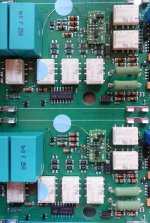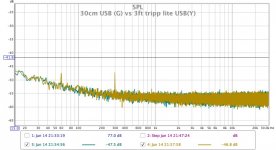I connected my HD650 headphones directly to the RTX and selected the RTX in the System Preferences Sound control panel (iMac). Works right away.
However, unfortunately, volume control is limited to the physical switches on the RTX... A three-step volume control is a bit rough even for a tolerant dane like me
How come software like ARTA, REW etc. can adjust the output, but "music" software like iTunes etc.cannot?
The best USB DAC in the world, but with a 3-step attenuator
P.S. To my personal taste the lowest output level (-20dB) is actually quite pleasant
The 0dB is party time, and I did not even try the 20dB as I fear for my headphones.....
However, unfortunately, volume control is limited to the physical switches on the RTX... A three-step volume control is a bit rough even for a tolerant dane like me
How come software like ARTA, REW etc. can adjust the output, but "music" software like iTunes etc.cannot?
The best USB DAC in the world, but with a 3-step attenuator
P.S. To my personal taste the lowest output level (-20dB) is actually quite pleasant
The 0dB is party time, and I did not even try the 20dB as I fear for my headphones.....
The first set of fix PCB that RTX sent me was loss in transit, but their support is great and they sent me a second set, which finally arrived yesterday. I'm impressed that they even prepare all the required wires with spares.
So I followed the instruction published by JensH and get the mod done today, it passed the test mentioned in post #686 and everything is working as expected. Now I'm tempted to try the transformer rotation mod of PaulBC.
I also tried listening to the RTX as DAC, works great with JRiver Media Center and it sounds very similar to my Lynx Hilo DAC, a very clean and neutral sound. I use a balanced headphone amp after the DAC, so volume control is not an issue.
So I followed the instruction published by JensH and get the mod done today, it passed the test mentioned in post #686 and everything is working as expected. Now I'm tempted to try the transformer rotation mod of PaulBC.
I also tried listening to the RTX as DAC, works great with JRiver Media Center and it sounds very similar to my Lynx Hilo DAC, a very clean and neutral sound. I use a balanced headphone amp after the DAC, so volume control is not an issue.
Attachments
@cwtim01
Looks good
Having a headphone amp is a good idea. I agree that 20 dB volume steps are a bit rough
@soongsc
The unbalanced outputs are just the (+) wire of the balanced output. So compared to the balanced output, the signal will be 6 dB lower. And the impedance is 50 ohm.
Looks good

Having a headphone amp is a good idea. I agree that 20 dB volume steps are a bit rough
@soongsc
The unbalanced outputs are just the (+) wire of the balanced output. So compared to the balanced output, the signal will be 6 dB lower. And the impedance is 50 ohm.
I am out of ideas. Two units no sound on two MacBooks. I checked the Audio Midi setup app while playing, when I start to play, the playback device symbol will jump away from the RTX, when I stop playing, it will jump back to the RTX. This is weird!
I am wondering, what data format should the RTX received? Integer or floating point?
I am wondering, what data format should the RTX received? Integer or floating point?
Last edited:
How come software like ARTA, REW etc. can adjust the output, but "music" software like iTunes etc.cannot?
The audio analysis tools adjust the amplitude of the test signal before sending the signal to the audio hardware. iTunes does not do that, but leaves the volume control to the operating system and the audio hardware itself. iTunes just tells the music playback system to set the volume accordingly. This function is implemented in almost all "soundcards" (often on the DAC chip, sometimes in the analog output stage).
Jriver actually allows doing it either way.
Did you try with using standard Apple software only? Maybe Jriver messed up / blocked the USB sound interface somehow? I had a similar issue with REW once.
I'd turn everything off (computer and RTX), disconnect USB cable, make sure no other audio intefaces are connected and no AirPlay devices within reach, restart computer and RTX, reconnect USB, and then try with iTunes without touching any other software first.
The next step would be to try with a non-Mac computer.
I have done all the Mac portion you mentioned. Even the basic speaker config option in the Audio MIDI setup app does not play sound to identify speakers. I am in the process of moving Windows based measurements to BootCamp on the MacBook as well. Other USB soundcards work fine. I will try the RTX later.
Sounds dumb, but I did not change the power line to the right voltage.[emoji849] Sounds amazingly neutral on first listening. Well damped. Using the recommended USB cable, there is totally no trace of sonic signature associated with longer USB cables I have tried with other devices.
Switching to my usual USB cable, the lower frequencies and the dynamics seemed be have a more weight into the music.
So I would be interested to see if measurements will show differences.
Switching to my usual USB cable, the lower frequencies and the dynamics seemed be have a more weight into the music.
So I would be interested to see if measurements will show differences.
Last edited:
I am wondering, what data format should the RTX received? Integer or floating point?
Definitely not floating point! It should be either 16, 24 or 32 bit fixed point.
Sounds dumb, but I did not change the power line to the right voltage.[emoji849] Sounds amazingly neutral on first listening. Well damped. Using the recommended USB cable, there is totally no trace of sonic signature associated with longer USB cables I have tried with other devices.
Switching to my usual USB cable, the lower frequencies and the dynamics seemed be have a more weight into the music.
So I would be interested to see if measurements will show differences.
So are you saying that you connected it to a 110 V line voltage, but with the unit set to 230 V?
I have actually not tried it. I could imagine that it will work to some extent, but you may get an increased hum level.
Doing it the other way around will probably blow a fuse or two.
I wouldn't expect the length and type of cable to make any difference at all, as long as data transmission is error free.
You know, I really to not fully understand how the output source impedance and load impedance ratio relates with the settling time of a signal. My current comments are really how I perceive how sounds die out listening through my active speakers.
If you use an amplifier after the RTX6001, the output impedance of the RTX6001 is not terribly critical. I assume that in this case the amplifier input impedance is relatively high, like 10k or higher.
Connecting it directly to headphones is a different matter of course.
- Status
- Not open for further replies.
- Home
- Group Buys
- GB for RTX6001 Audio Analyzer with AK5394A and AK4490

